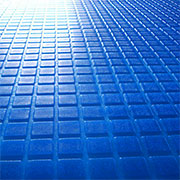Gel has also another important quality of absorbing the heat of its surroundings. It acts like a conductor and soaks up the temperature of the bedroom, which is much wormer than our body. When we lay down on the mattress gel will start soaking up temperature from our body instead. That is what is called “Cooling Effect” of gel, which is a main selling point of gel manufacturers. Once the gel fully absorbs and equals our body temperature, the cooling effect stops. This depends on the amount of gel and thickness of gel layer. Simply put, the mattresses with a thin gel layer will stay cool only a few minutes, where thicker gel layer can keep you comfortable for several hours. Unfortunately, it is still vague how does this work over longer period of time (overnight) and the changes in temperature might be very small to take advantage of.
This cooling effect is more pronounced the closer the body is to the gel layer. That’s why manufacturers usually put the gel layer on the very top of the mattress. In order to maximize the cooling action of gel you need to eliminate any extra insulating layers between your body and mattress – e.g. mattress pad or protector, flannel sheets, etc.
Gel is technically not cooler than any other material (maybe actually warmer) but it can temporarily provide cooling sensation to the body. Latest research by rival manufacturers did not confirm the claim of gel-based products sleeping cooler. Recent study by Tempurpedic and Cargill showed that some gel-based products actually slept a little warmer.

 Gel mattresses have become extremely popular in the last few years and “gel” is another mattress industry buzzword that is surrounded with much interest but not enough relevant information. Gel is a go to material for many manufacturers because it is popular among consumers and as they claim, it offers several advantages over memory foam or latex like improved temperature regulation, better resiliency, superior pressure relief and increased durability. You can find gel or form of gel in any mattress type available – innerspring, memory foam, latex and even air/dial beds nowadays may include layer of gel foam.
Gel mattresses have become extremely popular in the last few years and “gel” is another mattress industry buzzword that is surrounded with much interest but not enough relevant information. Gel is a go to material for many manufacturers because it is popular among consumers and as they claim, it offers several advantages over memory foam or latex like improved temperature regulation, better resiliency, superior pressure relief and increased durability. You can find gel or form of gel in any mattress type available – innerspring, memory foam, latex and even air/dial beds nowadays may include layer of gel foam.